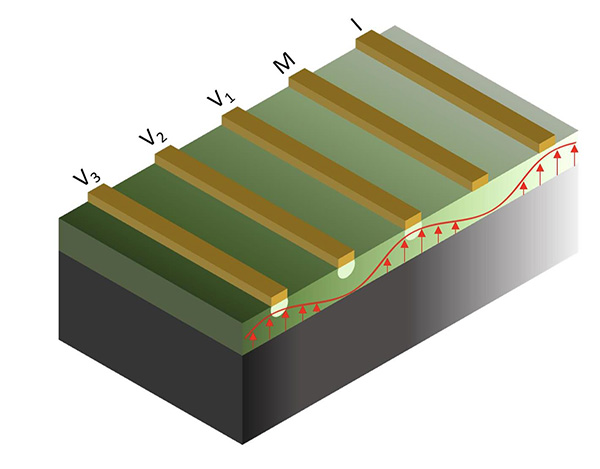
James Analytis
PhysicsJames Analytis is a Professor in the Department of Physics.
Project Description
Topological Mott Magnonics
Computation, the process of generating information, requires fast electrical manipulation and recall that often relies on non-linear electrical processes of the material platforms, dissipating large amounts of heat. In this proposal, we aim to address this challenge with a new technology that is rooted in the flow of spin that leverages the collective behavior of the electrons rather than the flow of individual particles. The solution we propose leverages a novel class of AFM materials known as Mott insulators (MIs). Spin and charge channels of dissipation are separated in such materials, so that information carried by the spin sector will not diffuse into the electronic sector, with potential to greatly reduce dissipation and enhance processor speeds.
James Analytis’ Story
In 1965, Gordon Moore of Intel predicted that microprocessors would double in speed and capacity every couple of years. This prediction, now known as “Moore’s Law,” has with some modification in 1975 been reliably prophetic until now. We’re fast approaching the limits of Moore’s Law at the same time as demands on microprocessor performances are continuing to grow at an ever more rapid pace. The solution may be in a burgeoning technology whose name reads like a character in the Marvel Universe – magnonics.

Photo: Peg Skorpinski.
Just as a photon acts like a wave of light and a phonon acts like an atomic-scale sound wave, a magnon acts like a wave of magnetism propagated by a quantum property of electrons known as “spin.” Bakar Fellow James Analytis believes magnons can be harnessed to meet future needs for high-speed, high-fidelity and energy-efficient data-processing that surpasses the limits of Moore’s Law.
Magnetized electrons act like spinning magnets that are configured in an “up” or “down” direction. This intrinsic quantum property known as “spin” can be used to encode information. In an exotic class of materials called Mott insulators, spin can be carried by magnons – sometimes referred to as spin waves. Analytis would like to use magnons to carry information. Since the electrons themselves remain stationary as magnons pass through them, there is no heat to be dissipated, the major limiting factor in Moore’s Law.
Analytis, an Associate Professor in the Physics Department who holds the Charles Kittel Chair in condensed matter physics and is also a faculty scientist with Lawrence Berkeley National Laboratory (Berkeley Lab), believes that the exploitation of magnons in Mott insulators could represent a new paradigm in information technology.
Q: Can you briefly describe what magnonics is and what advantages it offers over other microprocessor technologies?
A: All magnets have “magnetic order,” which means the spins of their electrons are locked together in a fixed configuration. Because the spins move collectively, when you ping one spin the motion moves through the others like a seismic vibration moves through the earth. Collective spins are carried by magnons just as individual spins are carried by the flow of electrons, but magnons carry spins faster and with lower heat dissipation than electrons.
Q: Most of the research into Mott insulators has focused on the flow of electron charge that enables these materials to transition from conductors to insulators. Why are Mott insulators well-suited for the study of magnons?
A: As far as we know no-one has seriously looked into this approach before, but Mott insulators have very unusual collective spin dynamics that should allow us to push their spins around into different configurations without expending much energy. We’re starting with heterostructures of Mott insulators and heavy metals that will enable us to add and remove spin in the Mott insulator.

Q: How will you apply your Bakar Spark Fund to this effort?
A: In the first year the fund will be used to fabricate a prototype Topological Magnon Transistor (TMT) in which spin would be the information transported. The TMT will be switched on and off by simply changing the spin configuration of the Mott insulator, which can be done by the judicious injection of spin in one direction or another. We expect this prototype to operate at three orders of magnitude lower power than related systems, and to be able to transport information at terahertz speeds across tens of microns, which beats other platforms by a factor of 20 or more.
Q: Where will this work be done?
A: We’ve been working with collaborators in Japan to fabricate heterostructured thin films. We’ll then make extensive use of the nanofabrication facilities at Berkeley Lab’s Molecular Foundry, especially the Focused-Ion Beam, Scanning-Electron Microscope, Electron Lithography, and Confocal Microscopy systems.
Q: What do you see as the most likely initial application of your proposed Mott magnonics technology?
A: Initially, I would guess memory, in which the spin configurations available in Mott insulators are used to store information. After that it would be logic and ultra-fast computing. Memory devices can be achieved straightforwardly, whereas data processing requires a bit more engineering. I believe we’re entering a new era in quantum devices, one not based on the simple physics of single electrons, but on the beautifully complex physics of collective electron motion.